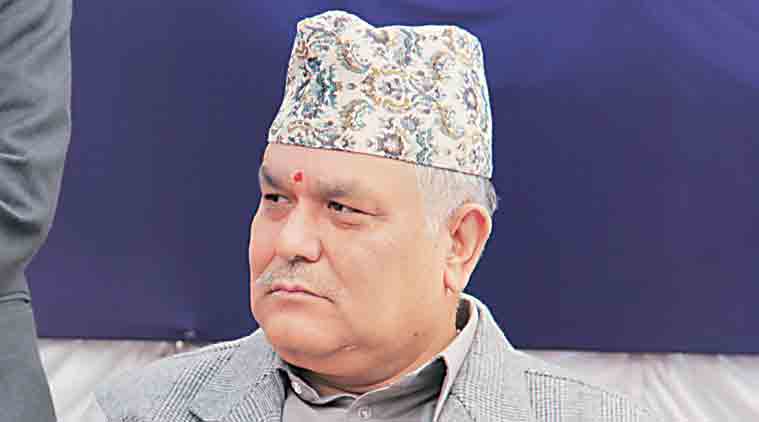- India
- International
Simly put: Why Nepal’s anti-graft chief Lokman Singh Karki faces the axe
For over a week, Kathmandu has been agog with news of the impeachment of the man heading Nepal’s top anti-corruption body.
 The Nepali House will take up Karki’s impeachment motion again on Nov 10.
The Nepali House will take up Karki’s impeachment motion again on Nov 10.
Lokman Singh Karki surprised many when he emerged as the unanimous choice of the top leaders of the Nepali Congress, Unified Communist Party of Nepal (Maoist), Communist Party of Nepal-Unified Marxist Leninist, and the Madhesi Forum to head the Commission of Inquiry into Abuse of Authority, Nepal’s anti-corruption constitutional body, some forty-five months ago.
The then government, headed by the Chief Justice of the Supreme Court, Khilraj Regmi, instantly appointed him to the post, despite widely aired views of the then President Ram Baran Yadav, that he would use all his power to stall the appointment. The President was subsequently quoted by a civil society leader who approached him as having said, “I could not defy Indian pressure”.
As head of CIAA, Karki repeatedly made news, and was often criticised for targeting the ‘small fish’ while letting the bigger ones slip through. But his summoning and subsequent arrest, in April, of journalist and civil society leader Kanakmani Dikshit in an alleged “corruption-related case”, and Dikshit’s release on the order of the Supreme Court, polarised opinion in politics, civil society and the media like never before. A motion to impeach Karki — signed by 157 MPs from both the ruling Maoists and the opposition CPN-UML — is now under debate in Parliament.
How did matters come to this pass?
Karki had long had a testy relationship with politicians, the bureaucracy and NGOs that are sometimes as powerful as the state in Nepal, but the flashpoint came two months ago when the Supreme Court decided to admit a review petition questioning Karki’s eligibility for the post of CIAA chief. His supporters allegedly obstructed the delivery of the summons, which infuriated parliamentarians who saw it as contempt. Ballast to their opposition was provided by an ongoing street mobilisation programme led by Dr Govinda K C — an orthopaedic surgeon and activist often seen as the Anna Hazare of Nepal — who has been accusing Karki of promoting corruption in certain medical colleges run by his relatives.
In Mid-September, the CIAA announced that it would probe, within a month, irregularities in the Maoist cantonment allegedly running into billions — clearly implying that Prime Minister Pushpa Kamal Dahal and Vice-President Nanda Kishore Pun, besides several Maoist ministers, would be investigated. It was perhaps on that day that the Maoists and the UML — which is believed to control the largest NGO network in the country — quietly began the exercise to collect the signatures necessary to initiate the impeachment process. On October 20 evening, a notice, to which was appended the signatures of 157 MPs, was given to the Parliament Secretariat — and Speaker Onsari Gharti, a Maoist leader, promptly wrote to the President and Prime Minister seeking Karki’s suspension, even before the House had taken up the issue. The secrecy and swiftness of the operation suggested the signatories were apprehensive of a reprisal from Karki — while both sides knew each other’s vulnerabilities, the MPs turned out to be better than Karki at strategy. On October 26, Prime Minister Dahal said, “I was on a state visit in India [to attend the BIMSTEC summit in Goa], and such an announcement could have been made upon my return… This was clearly intended to undermine the dignity of the Prime Minister.”

So where does the process stand now, and what happens from here on?
The House took up the impeachment motion formally on October 25, and will take it up again on November 10 when it reassembles. The outcome of the debate will be forwarded to the 11-member Impeachment Committee, in which the UML and Maoists have an absolute majority. The Committee, after due process and investigation, will send its recommendations back to the House for further debate and voting. For adoption, the motion will require the support of two-thirds of members present and voting. The Committee will frame the charges, and give Karki a chance to respond.
Under the Constitution, a notice for impeachment can be given by not less than three members which is referred to the Impeachment Committee for investigation. The Committee sends it back to the House with its comment — however, if at least one-fourth of the total membership gives the notice, it is admitted straightaway for debate. This is what has happened in the present case.
Prime Minister Dahal has justified the long recess until November 10 saying it is on account of Diwali and the visit of Indian President Pranab Mukherjee on November 2. It may take over two months for the process to be over.
And what is Karki’s alleged “Indian connection”?
Karki (61) entered the government service in the early 90s by Royal decree. He was, however, adopted and promoted by top political leaders, mainly G P Koirala of the Nepali Congress. He occupied important positions, and became Chief Secretary in early 2005 when King Gyanendra Shah took direct power for 14 months. After the collapse of the Royal regime, a controversial “judicial commission” that had representatives from major political parties, found him guilty of using government power and funds to suppress the movement. According to Karki’s revelations much later, he spent a couple of years in India with some spiritual gurus, mainly Pilot Baba, and came back a “Republican”, allegedly shedding all connections with his “past”. He built relations with the Maoists and Nepali Congress, allegedly with Indian mediation. After the CIAA opened a probe against Kanak Dikshit, the journalist publicly said RA&W had been behind Karki’s appointment. After the impeachment motion was moved, the Republic and Kantipur media groups alleged that Indian Ambassador Ranjit Rae had lobbied to save Karki. However, the four leaders who had recommended Karki for the post too are facing the ire of the people. Of them, Nepali Congress chief Sushil Koirala is dead; the other three — then UML chief Jhalnath Khanal, Madhesi floor leader Bijay Kumar Gachedar, and Prime Minister Dahal himself — have not yet explained why they backed him in 2013.
Where does the Nepali Congress stand?
The Nepali Congress, the largest party in the House and in the coalition government, is divided — and miffed at the way it was kept in dark by the two communist parties. “Why should we back the UML’s agenda,” asked Shekhar Koirala, a prominent leader of the party. But Nepali Congress chief Sher Bahadur Deuba says that while the party does not condone Karki’s actions, it would take a formal position only after studying his response to the Committee.
The Nepali Congress���s support is crucial for the motion, which needs 397 votes to pass. If the motion is defeated, the alliance between the Maoists and the NC may face stress, and lead to the fall of the government. The Madhesis and pro-Hindutva groups like the Rastriya Prajatantra Party and RPP-N have opposed the move.
And what impact could this crisis have on Nepal’s fledgling democracy?
Many fear the impeachment move may trigger similar moves against other constitutional entities, such as the President, Vice President, Speaker and judges, including the Chief Justice, of the Supreme Court, as all these posts were allegedly filled through a “political quota system”.
More Explained
EXPRESS OPINION
Apr 26: Latest News
- 01
- 02
- 03
- 04
- 05










































